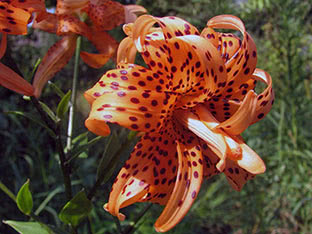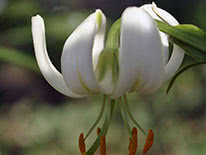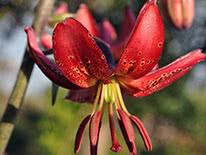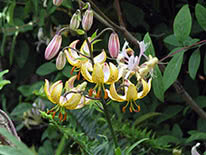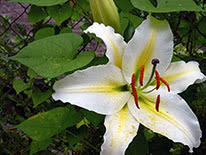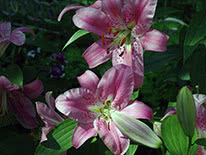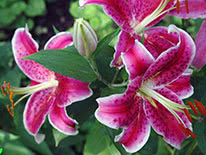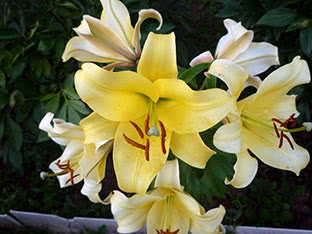Lilies: growing, planting, care, varieties
 Lily (lat. Lilium) is a genus of plants in the family Liliaceae that is a perennial herb growing from bulbs. In nature there are about 80 species that gave life to many varieties and hybrids through cultivation. Lilies grow in Asia, Europe and North America. An ancient Gaelic word “li-li” means “white-white”, and although in nature there are species with both pinkish and yellowish flowers, the name of the flower is apparently derived from a species known as “lilium candidum”.
Lily (lat. Lilium) is a genus of plants in the family Liliaceae that is a perennial herb growing from bulbs. In nature there are about 80 species that gave life to many varieties and hybrids through cultivation. Lilies grow in Asia, Europe and North America. An ancient Gaelic word “li-li” means “white-white”, and although in nature there are species with both pinkish and yellowish flowers, the name of the flower is apparently derived from a species known as “lilium candidum”.
Lily is associated with many legends: the ancient Greeks said that the white flowers of lily were the drops of the milk of Hera, the wife of Zeus; the Jewish legend tells that among all flowers of paradise after the Fall of Eve only lily retained its purity and chastity; in the Christian culture white lily (lilium candidum) is the symbol of the Virgin Mary.
Very often the lily flower is used in heraldry. Poets and writers also often mention this flower in their works. But in addition to beauty, lily also has unique healing properties: an ancient Greek physician in the Roman army Dioscorides, in his work “On Medical Material” told contemporaries and descendants that lilium candidum and lilium martagon healed wounds, bruises, burns and abrasions, helped in the treatment of heart diseases and relieved toothache.
Description of lily flower
The lily plant is a bulb perennial. Bulbs can be tiny – 0.4 inch in diameter, and can be large – up to 11.8 inches in diameter. Their shape can be spherical or ovate, scales are attached to the bottom where the root growth point is located, on the opposite side of the bulb the scales do not close up, therefore the lily bulbs look loosely. The lily stem is straight, leafy, unbranched at the top, depending on the species and variety it is from 6 inches to 8.2 ft in length. The leaves of some lily species are wrapped in a spiral along the stem, while the leaves of other species form basal crown.
The lily flowers are collected in inflorescences of cylindrical, conical or umbellate forms of 8-16 flowers, but some species have up to 30 flowers in the inflorescences that bloom gradually starting from the lower to the upper ones. Flowers live from 3 to 9 days. In the center of the flower there are the pistil and 6 stamens with large anthers, around which there are 6 petals (or even more for double varieties). The shape of flowers is diverse – star-shaped, reflexed, funnel-shaped, tubular, flat, cup-shaped, bell-shaped... Often the size of the flower depends on its shape: reflexed lilies reach 2-4 inches in diameter and are very similar to Chinese lanterns; funnel-shaped flowers have only 1.6 inches in diameter, while in length they are 6 inches; flat flowers can be up to 10 inches in diameter! Petals also come in a array of colors: snow-white, orange, apricot, tender pink, bright scarlet, dark-violet, bicolour, iridescent, with spots, strokes or fringes ... but there are no blue lilies. The fruit of lilies is a long capsule with flat seeds ripening by October-November.
Species and varieties of lilies
What lily?
In nature and cultivation there is a great variety of lilies, and all of them are of interest to gardeners. We offer you the classification of lilies according to the latest edition of the International Lily Register that describes more than 3,500 varieties.
Asiatic lily
This group includes garden forms and hybrids of such lilies as: tiger lily and David’s lily, nodding lily and lovable lily, lilium maximowiczii and low lily, lilium conclor and lilium bulbiferum, lily maculatum and Dutch lily. Asiatic lily and its varieties have small white bulbs. These lilies are vigorous, winter-hardy, minimal care plants that are well propagated by babies and scales. They bloom earlier than other lilies at the end of June. Among Asiatic hybrids there are dwarf varieties of 8-16 inches in height, and there are also tall lilies up to 5 ft tall. Some varieties form bulbs – air bulbs in leaf axils, and for this they are called bulbous. Flowers can be white, yellow, orange, of cream shades, there are varieties of two- and three-color, as well as varieties with red, dark red and almost black flowers. The flower is mostly cup-shaped or reflexed, from 3.2 to 8 inches, consisting of 6 petals, although there are several double varieties. The varieties of Asiatic group are as follows:
- Adelina lily is a mid-sized yellow lily, early variety, profusely blooming;
- Blazing Dwarf lily belongs to dwarf variety, early and abundantly flowering, it can be grown even in pots;
- Flore Pleno is a double lily with orange flowers of medium size, with high sturdy stem, it blooms late.
Martagon hybrids
They are also called turk’s cap lilies that include lilies originating from martagon lily, Hanson’s lily and Manchurians Turk’s cap lily, lilium tsingtauense and lilium medeoloides. There are about 100 varieties of this group. They are characterized by high growth, drooping flowers are of Turk’s cap form and of gentle shades of different colors. The advantages of the lilies of this group are frost resistance, unpretentiousness in soil and lighting, vigorousness, high ornamental qualities, insusceptibility to viruses and good resistance to all kinds of rot. But, unfortunately, Martagon hybrids have not yet gained wide popularity. Varieties of Martagon hybrids are:
- Manitoba Fox is a lily-tree 6-7.8 ft tall, with numerous flowers of dark pink with pale yellow color and with black-and-yellow spots;
- Martagon Album is a tall lily with numerous flowers that are snow-white with yellow stamens and of Turk’s cap form. Up to 50 flowers bloom at a time;
- Mrs. R.O. Backhouse is a pink lily with a yellow tint and dark pink spots.
Candidum hybrids
 This group includes garden forms that gave rise to white lily, or, as it is often called Madonna lily, crossed with lilium chalcedonicu and other kinds of European lilies. The specimen of the species is nankeen lily (lilium x testaceum). There are very few varieties of of this species, but instead they are all very fragrant, the flowers have the shape of a wide funnel or tubular, the flower color comes in all shades of yellow or white. The varieties of this species have the bulb scales turning into leaves and forming a rosette. The disadvantage of the species is susceptibility to fungal diseases, in addition, these hybrids poorly produce seeds. The varieties are:
This group includes garden forms that gave rise to white lily, or, as it is often called Madonna lily, crossed with lilium chalcedonicu and other kinds of European lilies. The specimen of the species is nankeen lily (lilium x testaceum). There are very few varieties of of this species, but instead they are all very fragrant, the flowers have the shape of a wide funnel or tubular, the flower color comes in all shades of yellow or white. The varieties of this species have the bulb scales turning into leaves and forming a rosette. The disadvantage of the species is susceptibility to fungal diseases, in addition, these hybrids poorly produce seeds. The varieties are:
- Apollo is a white lily, fragrant bells of 4-4.7 inches in diameter are collected by 9-10 pieces in a truss;
- nankeen lily has cream-colored flowers of Turk’s cap form.
American hybrids
They are derived from the crossing of the leopard lily, Humboldt’s lily, Canada lily, Columbia lily, Bolander’s lily, lemon lily, etc. Besides them, the group includes Bellingham hybrids and Burbankii hybrids – about 150 varieties in all. Flowers are diverse in form and color. These hybrids thrive in weakly acidic soil, abundant watering and good drainage, they do not tolerate transplanting. They bloom in July. They are frost resistant. The varieties are:
- Shuksan is a golden lily with brown spots, tips of petals are pink;
- Cherrywood is a red lily.
Easter lily hybrids (lilium longiflorum)
 It includes garden forms obtained from Easter lily, lilium formolongi, Formosa lily, etc. Flowers of these hybrids are mainly of white or light shades. These lilies love warmth, so in winter they have to be well covered. In addition, they are easily infected with viruses. But they are ideal for forcing treatment and growing at home. The best varieties are:
It includes garden forms obtained from Easter lily, lilium formolongi, Formosa lily, etc. Flowers of these hybrids are mainly of white or light shades. These lilies love warmth, so in winter they have to be well covered. In addition, they are easily infected with viruses. But they are ideal for forcing treatment and growing at home. The best varieties are:
- White Fox has flowers up to 4.7 inches in diameter, outward-facing, white with yellow. The length of the tube is 6.3 inches, the height of the plant is 51 inches;
- White Haven has white flowers with light green center, stamens are yellow-orange.
Trumpet hybrids
They come from Asiatic lily species (Henry’s lilies), but without crossing with such species as golden rayed lily, Japanese lily, bamboo lily and maiden lily. These hybrids are frost-hardy, but they love fertile soil, are not susceptible to viruses and fungi, they are easily propagated by any method. These are the most popular representatives of the genus in the gardens in cold climate zone, blooming for three months until the end of September. Trumpet lilies are divided into four subgroups according to the shape of a flower:
- tubular flowers (the groups “Black Dragon”, “Golden Clarion”, “Sulfur Queen”, etc.);
- cup-shaped, or bowl-shaped, outward-facing (the groups “Heart's Desire”, “New Era”, “Gwendolyn Anley”);
- drooping flowers (the groups “Christmas Day”, “Golden Showers”;
- star-shaped flowers (the groups “Mimosa Star”, “Mimosa Star”, “Havemeyer”).
Oriental hybrids
These are the hybrids of the East Asian species: maiden lily, Japanese lily, golden rayed lily, bamboo lily and Henry’s lily. Flowers are cup-shaped, flat, of tubular and Turk’s cap forms. Oriental lily has both all merits of the lily genus and some of its shortcomings: its hybrids are difficult to grow, they are poorly propagated and highly susceptible to viral diseases and fusariosis of the roots. These hybrids bloom only in 5-6 years, 3-5 new bulbs appear annually. The varieties are:
- Anais Anais is a white lily with a yellow central vein, nectaries are yellow-green, stigma is lilac, petals are wavy, tips are wrapped, stems are 4.1 ft high;
- Ascari is a lily of lilac-crimson color with a yellow center and dark specks, the edge of the petals is wavy, the height of the stem is 3.4 ft;
- Barbados is a large lily (its diameter is 8.6 inches), dark crimson with a white trim along the edge of wavy petals with curved tips, with dark specks and white throat, stigma is dark purple.
LA hybrids
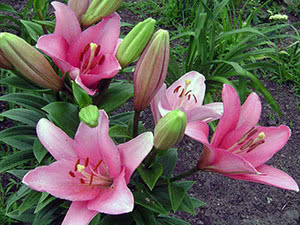 These are hybrids of Longiflorum hybrids (Easter lilies) and Asiatic hybrids. These double hybrids are very resistant to fungal diseases, winter-hardy, come in a wide range of shades from white to dark red and of all possible variations. Their flowers are larger, more beautiful and denser than of the “Asians”, and the fragrance is more gentle. The stems of LA hybrids are strong, but without “bulbs”. The varieties are:
These are hybrids of Longiflorum hybrids (Easter lilies) and Asiatic hybrids. These double hybrids are very resistant to fungal diseases, winter-hardy, come in a wide range of shades from white to dark red and of all possible variations. Their flowers are larger, more beautiful and denser than of the “Asians”, and the fragrance is more gentle. The stems of LA hybrids are strong, but without “bulbs”. The varieties are:
- Brindisi is a large-flowered hybrid of gentle pink color, very profusely blooming, tall;
- Eyeliner is a large-flowered hybrid of white color with cherry spots, tall;
- Freya is a flower-chameleon: large yellow flowers turn cream-white with an unique yellow pattern. It is a tall lily.
OT hybrids, or orienpets
They are the result of crossing of oriental hybrids with trumpet hybrids. The stems are tall, strong, the flowers are very large (up to 10 inches) in the form of a wide cup or funnel-shaped, outward-facing. Flower color can be pink, yellow, red, orange, there are also multicolor varieties. Lilies of OT-hybrids are cultivated in cut-flower farms, but breeders are actively working on breeding the varieties suitable for growing in the open fields. The varieties are:
- Beverly Dream is a very beautiful hybrid. It is star-shaped, with white trim and wine-red throat;
- Big Brother is a very large flower (more than 10 inches) of yellow-vanilla color with black stamens;
- Black Beauty is almost black lily (red-cherry with lilac-violet hue) of Turk’s cap shape, downward-facing, along the edge there is a thin white fringe, with very long stamens.
In addition to the described species and their hybrids, in recent years new hybrid groups have appeared: LO hybrids are the result of crossing longiflorum hybrids with oriental hybrids; OA hybrids are the result of crossing oriental and Asiatic hybrids; LP hybrids are the lilies obtained from crossing trumpet lilies with longiflorum lilies; AA hybrids are the result of crossing Aurelian lilies with Asiatic hybrids, and many others. It should be said that many beginning gardeners believe that the Amazon lily is one of the varieties of lilies, in fact it is an eucharis flower, also a bulbous plant that belongs to the Amaryllis family. As for such an amazing plant as a black lily, there are many varieties of lilies with very dark petals of red, purple and brown hues, but popular flower is actually called “tacca” or “black bat flower” and it belongs to the family Dioscoreaceae.
Growing lilies in the garden
How to grow lilies
Since lily grows in one place for several years and does not like transplanting, you need to choose a spot where lilies will comfortably grow and bloom – an area with full sun and protected from the wind. The soil must be loose, fertile and well-drained. As for the acid-base balance, different lilies prefer different compositions. American hybrids, for example, love acidic soil, while trumpet lilies thrive in alkaline soils. All other species and varieties grow well in neutral soil. Approximately 2-3 weeks before planting, dig up the soil with adding ash (only if you are not going to plant oriental hybrids – they love acid soil), peat and humus, a little mineral fertilizer. Then level the area, lightly compact and water the soil.
Lily bulbs
Before you buy bulbs, try to find out to what variety of lilies they belong to, because growing requirements depend on this fact. When buying try to choose juicy, healthy and fleshy bulbs, with non-dried scales and undamaged bottom. Pay attention to the length of the roots – they should not be shorter than 2 inches. If you purchase the bulbs in autumn, then until the middle of October, when you have to plant them, keep them in wet moss, sand or sawdust in a dark room with good ventilation or store them directly in the manufacturer packaging in the vegetable box of the refrigerator.
Before planting, the bulbs should be cleaned from rusty scales with brown spots, rotten or suspicious places and wilted or too long roots are cut out, then immerse the bulbs in a 0.2% solution of a fungicide for half an hour.
Planting of lilies
When to plant lilies
You can plant lilies in spring and autumn. You can plant lilies even in summer. Spring planting of lilies allows to avoid the risk of swelling and freezing of bulbs in the open ground. In spring, roots grow better, so the plant survival rate is higher, especially for late-flowering lilies, such as, for example, oriental hybrids. In March, you can plant regal and tiger lilies, as well as other varieties flowering in autumn. Oriental, Asiatic and trumpet hybrids are planted as soon as the snow melts. Double lilies should also be planted in spring at 52 °F. The remaining varieties of lilies are planted in the second half of April, protecting the planting site from frost by a layer of straw or dry grass. Such species as lilium candidum, lilium monadelphum, martagon lily, Hanson’s lily, Canada lily, and also lilium szovitsianum should not be planted in spring.
And yet autumn is the best time for planting lilies, because their root system has time to get developed before winter, and they will be able to perfectly tolerate the spring temperature drops, and you will help them survive the winter cold. The best time for autumn planting of lilies is September, but the problem is that at this time it is difficult to find good planting materials in plant nurseries. But in autumn you can plant and transplant the lilies growing in your garden. If you plan to plant several varieties of lilies in your garden, then it is better to follow this order: first (in autumn) plant white lilies, since they have the shortest dormant period, then the Caucasian varieties and only then American hybrids.
Planting of lilies in spring
For those who want to know how to plant lilies the time of the year does not matter: both spring and autumn planting have the same principals. Coarse-grained sand is poured into the planting hole, the bulb is placed in it, its roots are straightened and fully sprinkled with sand. Then the hole is filled with the soil and well watered for the bulbs to take root quickly. If you plant oriental, Asiatic and LA hybrids, cover the planting site with a 2 inch layer of sawdust or peat, and the planting site of martagon lilies, Madonna lilies or trumpet lilies should be mulched with leaf humus mixed with ash. As for the depth of planting of the bulb in the ground, here is an approximate scheme:
- low-growing varieties: large bulbs are planted at the depth of 4-4.7 inches, small bulbs are buried at 2.7-3 inches, the distance between bulbs should be 6-8 inches;
- mid-growing varieties: large bulbs are planted at 4.7-6 inches deep, small bulbs are at 4 inches deep, the distance between bulbs should be 8-10 inches;
- tall varieties: large bulbs are planted at 6-8 inches deep, small bulbs are at 4-4.7 inches deep, the distance should be 10-11.8 inches.
The deeper the planting is, the later lily will bloom, but its bulb will produce more babies instead.
Planting of lilies in autumn
In autumn, if your lilies grow too thick, it makes sense to separate them and plant them out. Planting and care for lily in autumn are about the division and planting out of the bulbs. Actually, there is no need to wait for autumn, and you can transplant the lilies in a month or one and a half after it has faded, especially if it is three or four years old. Immediately after flowering the bulb is weak, loose. Give it a little time to recover. That is, if your lily bloomed in June, for example, then it can be transplanted in August. Dig out the lily with a pitchfork without damaging its roots, shake off the ground, rinse it under running water, separate the babies from the mother bulb with a sharp knife and soak them in a pale pink solution of potassium permanganate for 20 minutes, then lightly dry it in the shade, trim the roots so that they are not longer than 4 inches, and plant the bulbs and babies in the way described in the previous section. Do not forget to mulch the planting spot after planting.
Care for lilies
How to care for the lilies in the garden
Care for lilies mainly implies watering and fertilizing. As for the light, the lily should be in full sun having “cold feet”, that is, the lower part of lily should be in shade. This is a simple rule. Sunlight for lily is very important in the morning. As for the “feet”, it is advisable to plant low-growing garden plants between lilies: when covering the ground, they will not let the soil get overheated and dried up, and will consequently protect the root system of lily.
Moisture is necessary for lilies throughout all growing season, but it is the most important in the first half of summer. But do not keep the soil wet all the time, lilies do not like it. Watering is carried out in a dry summer under the root in the morning or in the afternoon, after watering the soil should be gently loosened, unless you have mulched the soil around lilies to prevent its drying out. After flowering, watering can be reduced, but lily will have to be watered until late autumn.
First time lilies are fed in the early spring before the shoots appear above the ground: a combined fertilizer at a rate of 1 oz per 11 ft² is applied. The same dressing should be applied during the budding period. When lilies finish blooming, their bulbs will require potassium phosphate fertilizers to recover: 0.35 oz of superphosphate and 1 oz of potassium sulfate per 11 ft². If your lily is one year old, it will be better to carefully remove the buds, not allowing them to open, so that it saves its resources, gets strengthened and the next year it will please you with a full flowering. Deadhead the spent flowers as well, since they prevent the development of new ones.
Possible difficulties in growing of lilies
Do your oriental hybrids badly overwinter? This can be if in your climate zone autumn is damp, rainy. The fact is that in nature they grow in areas where spring and summer are wet, while autumn and winter are dry. Therefore, you just need to cover the planting site of oriental hybrids with foil during the autumn rains, removing it for airing only in dry weather. In this way you will protect your lilies from decay and prepare them for overwintering in dry soil.
Your lilies quickly fade and their flowering is not long-lasting? The reason may be that you planted them in the low area, and lily does not respond well to the waterlogging of the soil and the stagnation of moisture in the roots. The second reason of quick fading may be overheating of the soil: the soil must be necessarily mulched with light-reflecting materials – mown grass, sawdust, straw.
If your lily often gets sick, it may be because you apply manure as a fertilizer. Do not forget that it is saturated with pathogenic microflora, and do not use it as a fertilizer for lilies. Lilies do not tolerate organic material at all!
Pests and diseases of lilies
Scarlet lily beetles with its larvae eating buds and leaves are the most dangerous for lilies among the pests. Beetles can be collected by hand, since their orange backs are clearly visible on plants, but if they have become very prolific, you will have to spray the plants with malathion, Actellic, or with any other insecticide. Unfortunately, insecticide-treated lilies lose their appeal as their leaves and buds get covered with brown spots. The same drugs are used in case of attack of liriomyza urophina or aphids.
Lily bulbs can get damaged by mole crickets, wireworms, larvae of the May beetle and thrips, that are very difficult to fight with, but pesticides will help you control them. Mice that like to eat the bulbs of lilies are controlled with dusting of beds with colloidal sulfur or between lilies you can plant daffodils and hazel grouses that scare off rodents with their scent.

An excessive moistening of the soil can lead to the development of fusariosis (basal rot) and bacterial soft rot, causing the plants to turn yellow and wilt. Decayed bulbs must be removed from the soil and destroyed. If autumn in your area is cool and damp, then there is a risk of development of leaf mold that without affecting the bulbs kills the plant. To save lilies, you need to spray them with fungicides, for example, Bordeaux mixture.
As a preventative measure, it is necessary to burn all plant remains of lilies (stems, leaves) annually, and at least once every three years you should divide and plant out the bulbs for the planting site not to get thick. In addition, you should mulch the soil around lilies to prevent the appearance of weeds.
Lilies after flowering
When lilies fade, do not hurry to cut off the peduncles, but it is advisable to remove the seed boxes if you do not need seeds so that the leaves and stems will keep “working” until fading, delivering nutrients to bulbs for lily growth and flowering in the next year. In autumn, the flower stem can be cut obliquely, but not very low (4-6 inches above the ground level). Keep watering, if necessary, until it is the time to divide and plant out the bulbs of lilies. After bulb transplanting and the end of heavy autumn rains, frost-resistant lilies can be just covered with peat or shavings of coniferous species, and gentle oriental hybrids should be well wrapped with fir twigs, and covered with polyethylene foil for insulation. In spring, the foil and fir twigs will need to be removed not to damage the sprouts, and peat and sawdust can remain on the site as mulch.
Storing of lily bulbs
It is undesirable to keep the bulbs of some varieties of lilies in the ground until spring, especially if winters are frosty and snowless. So the bulbs of oriental hybrids, candidum varieties or regal lily should be dug out. The place of storage of lilies must meet the following requirements:
- not to be too dry, otherwise the bulbs can get wrinkled in winter;
- not to be too wet, otherwise the bulbs can get moldy or germinate earlier than it is needed;
- the temperature should be moderate (warm);
- good ventilation is necessary.
Bought or dug out from the soil bulbs of lilies should be slightly dried and cleaned from the ground. Put some peat into a wooden box, cardboard box or a packet, put bulbs in it, sprinkle them with peat again, put a layer of bulbs over it. When the box is full by two-thirds, it is stored in a refrigerator, in a cellar or on a loggia. But do not forget to check the condition of the bulbs from time to time: if the roots are dry, spray the peat with water, if, on the contrary, there is mold, treat the bulbs with a concentrated solution of potassium permanganate.
The second way of storage is: place bulbs in a plastic bag with moist peat, then blow it up, tie and place it in a dark place at room temperature. In two or three months the bulbs will form babies. Without separating the babies, transplant the bulbs into peat pots, so that the tip of the scales is above the surface, and take them out to a cool, but non-freezing cellar. Two weeks before planting, take them indoors and start watering.


